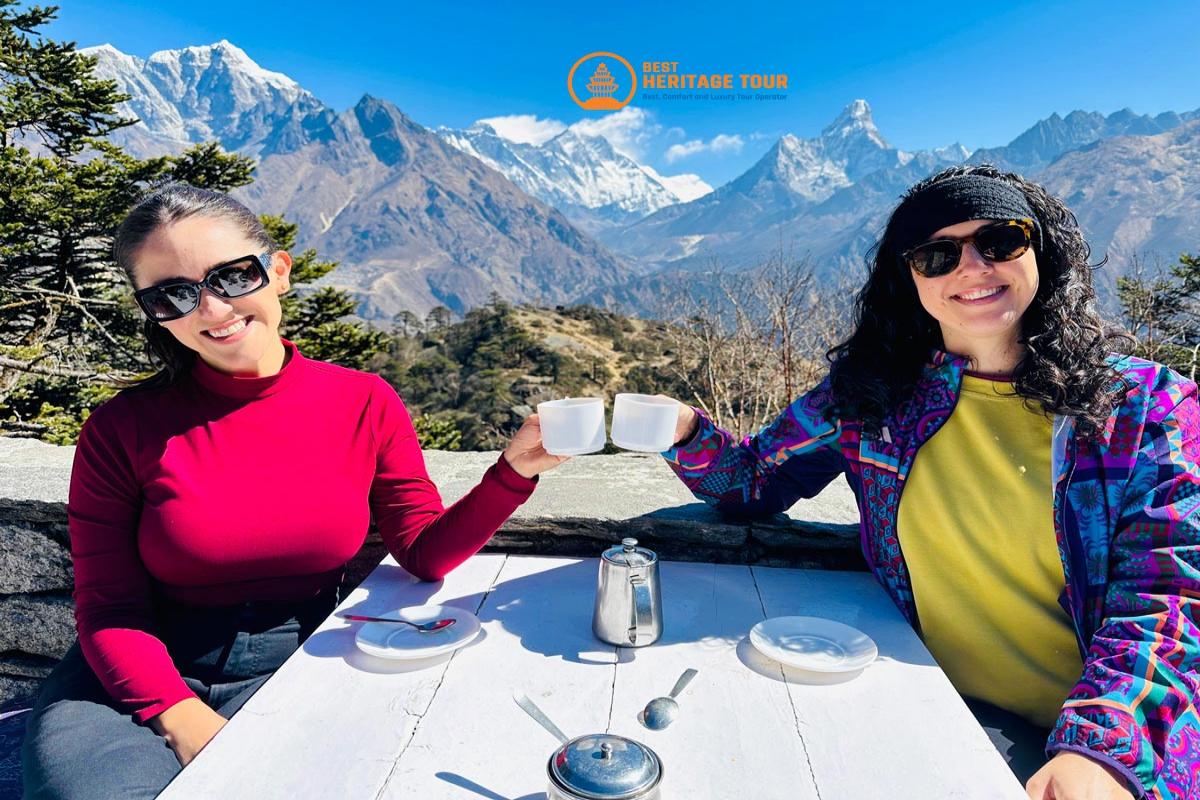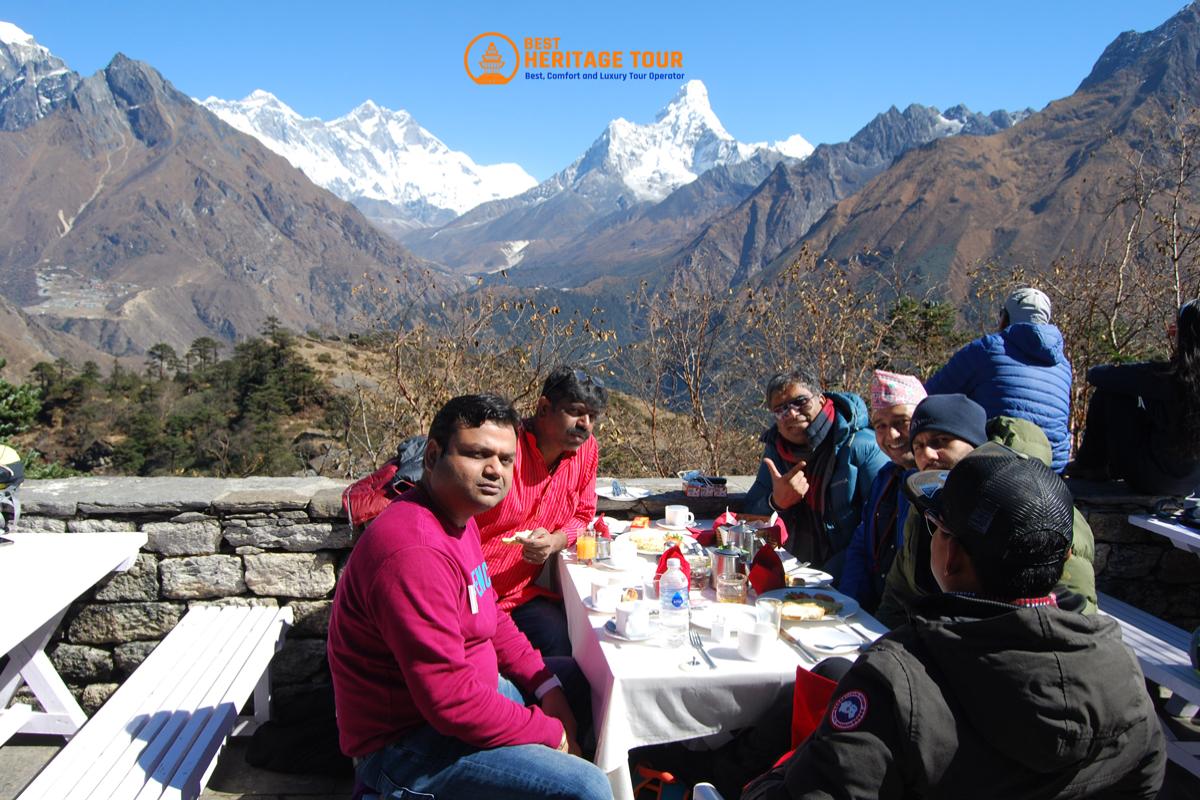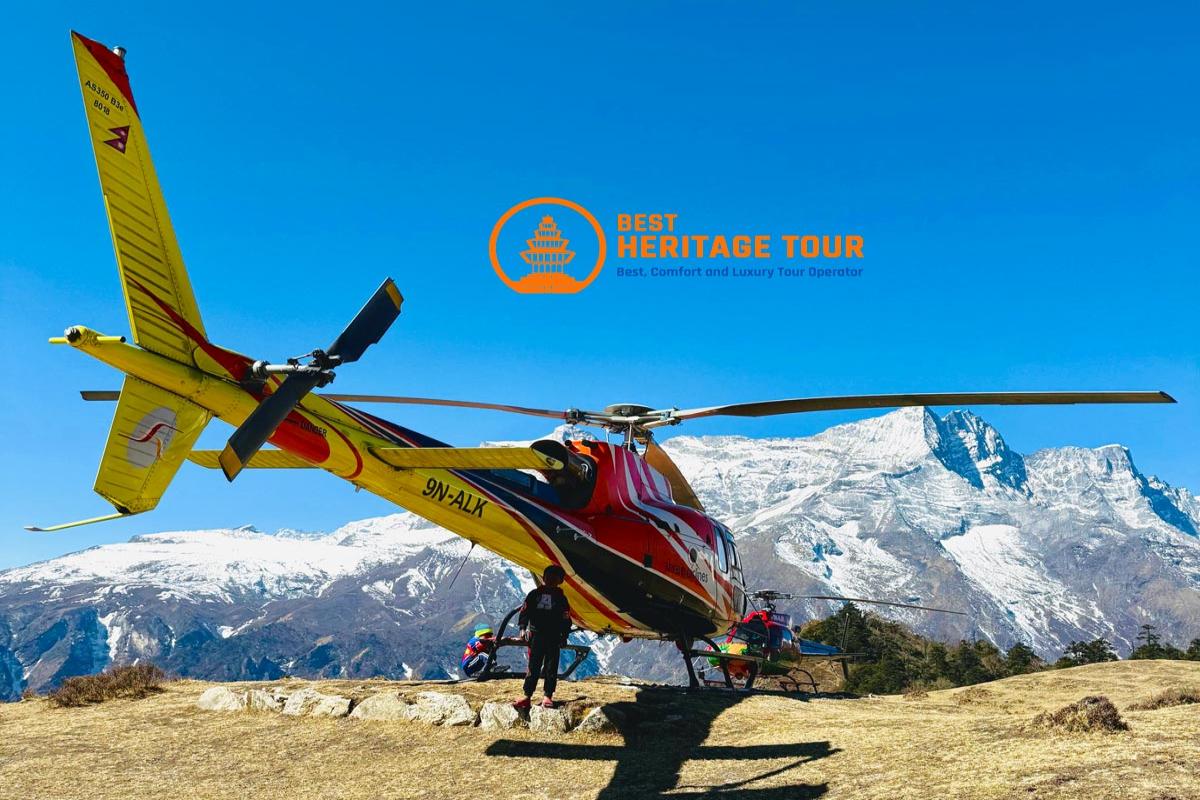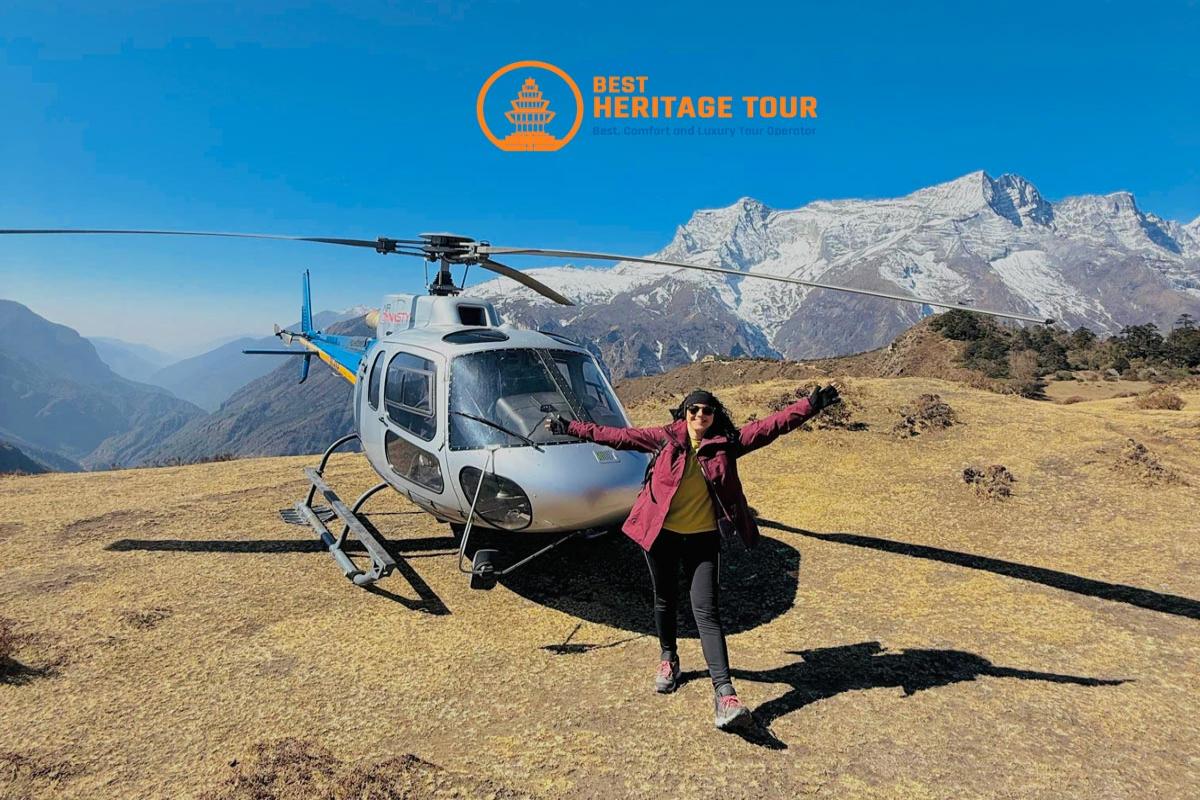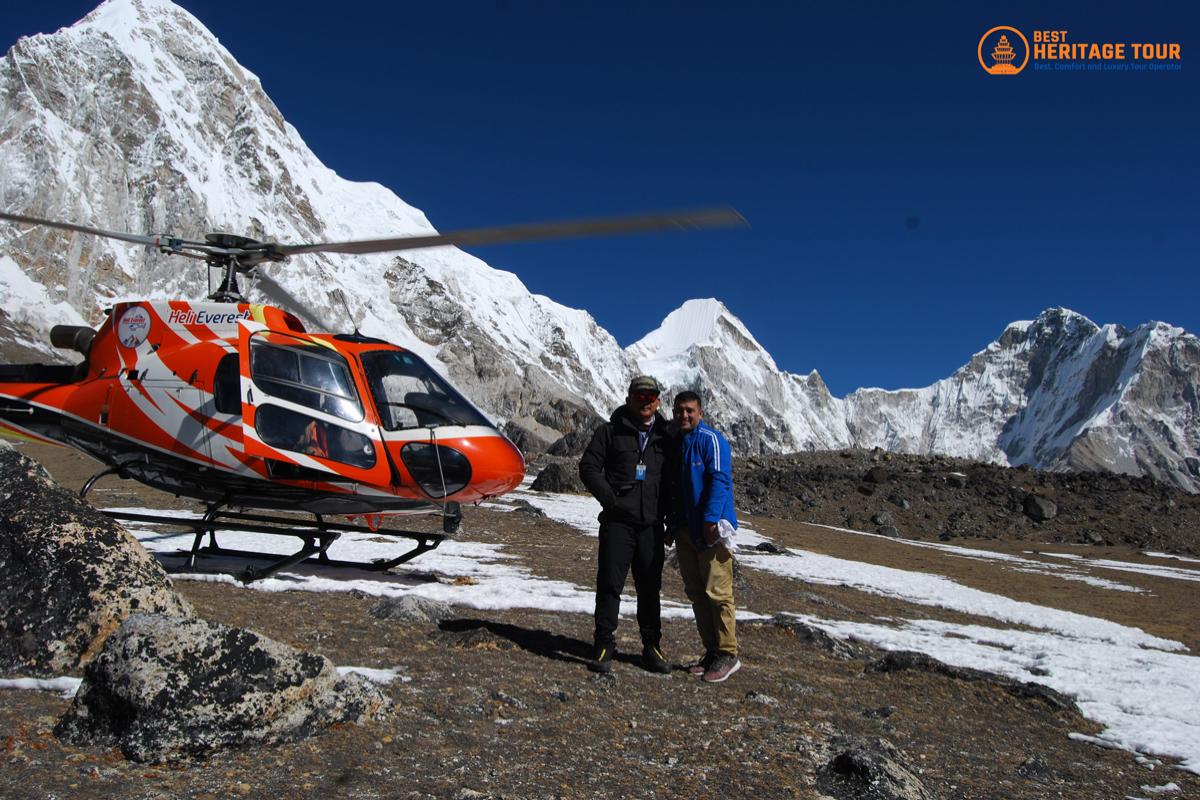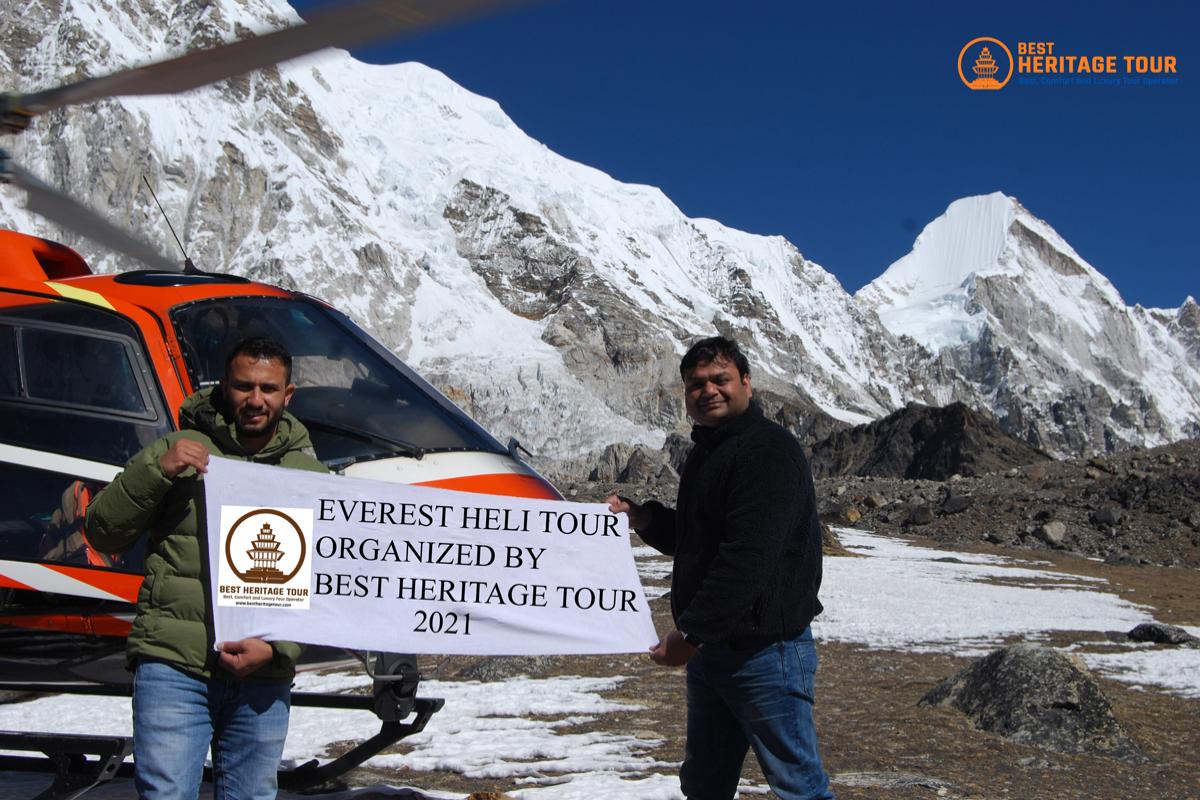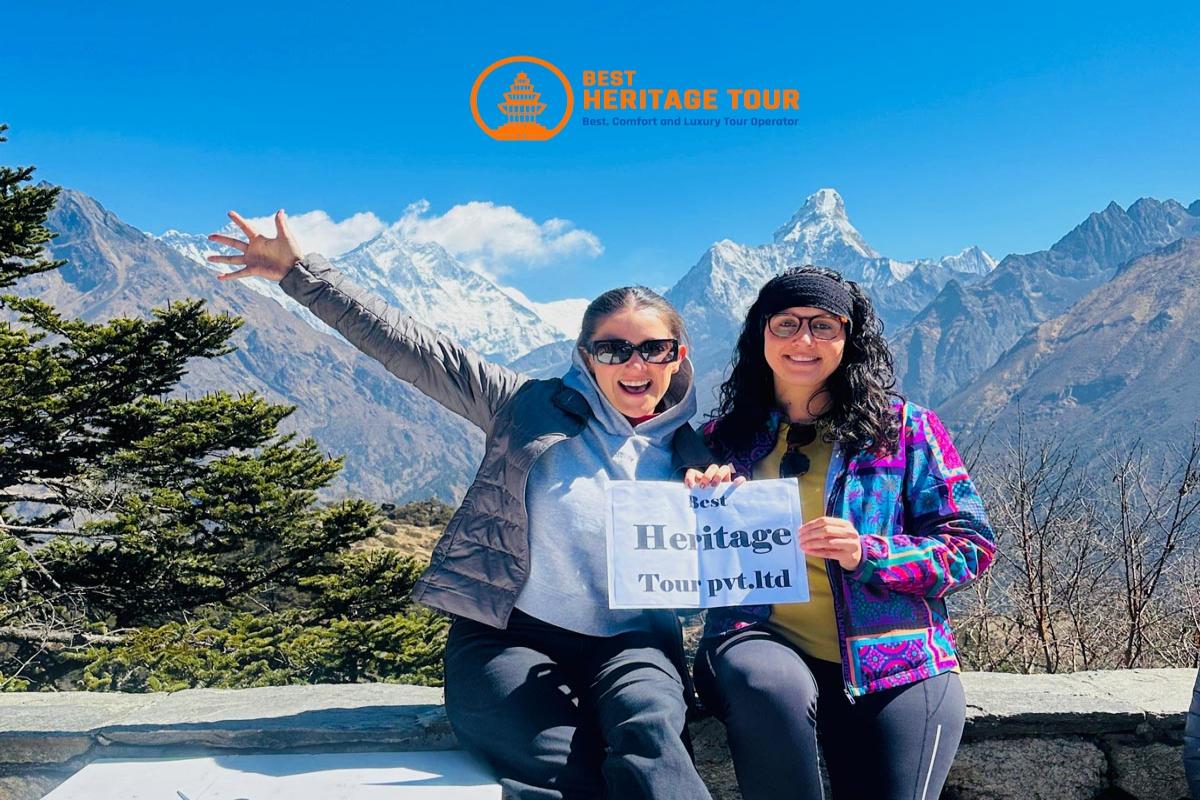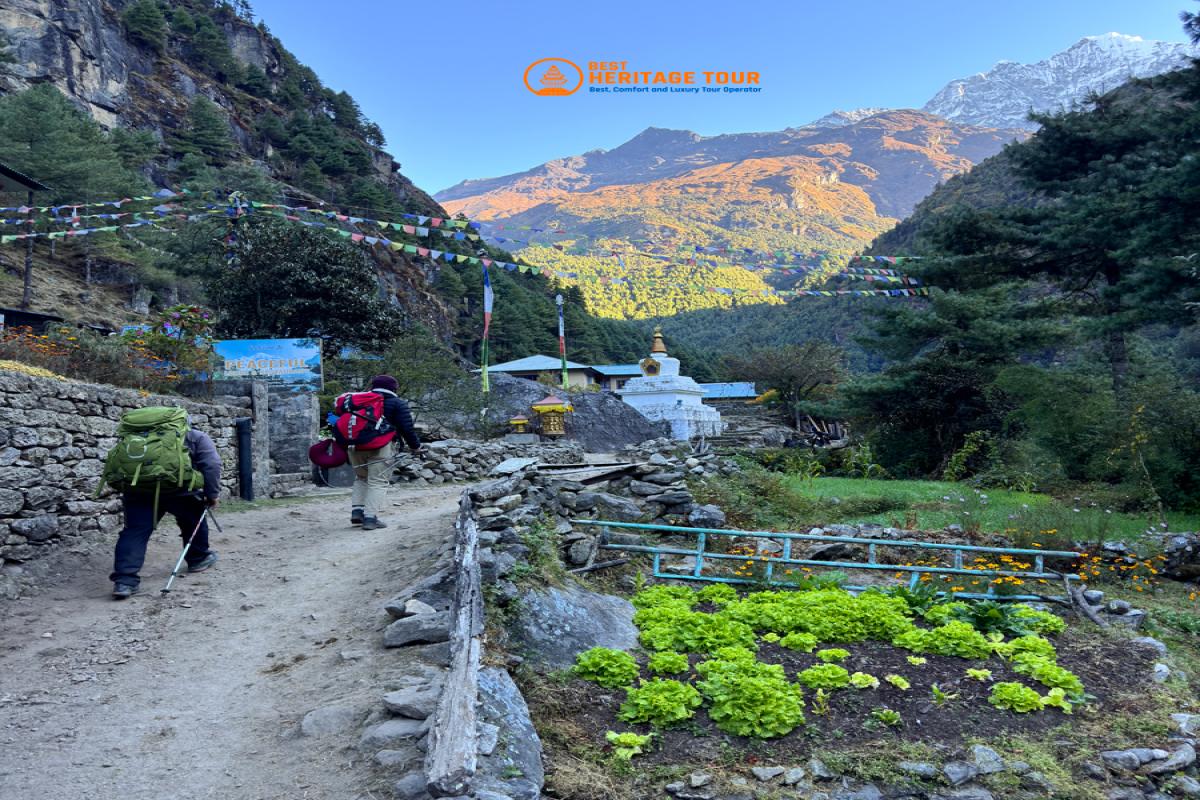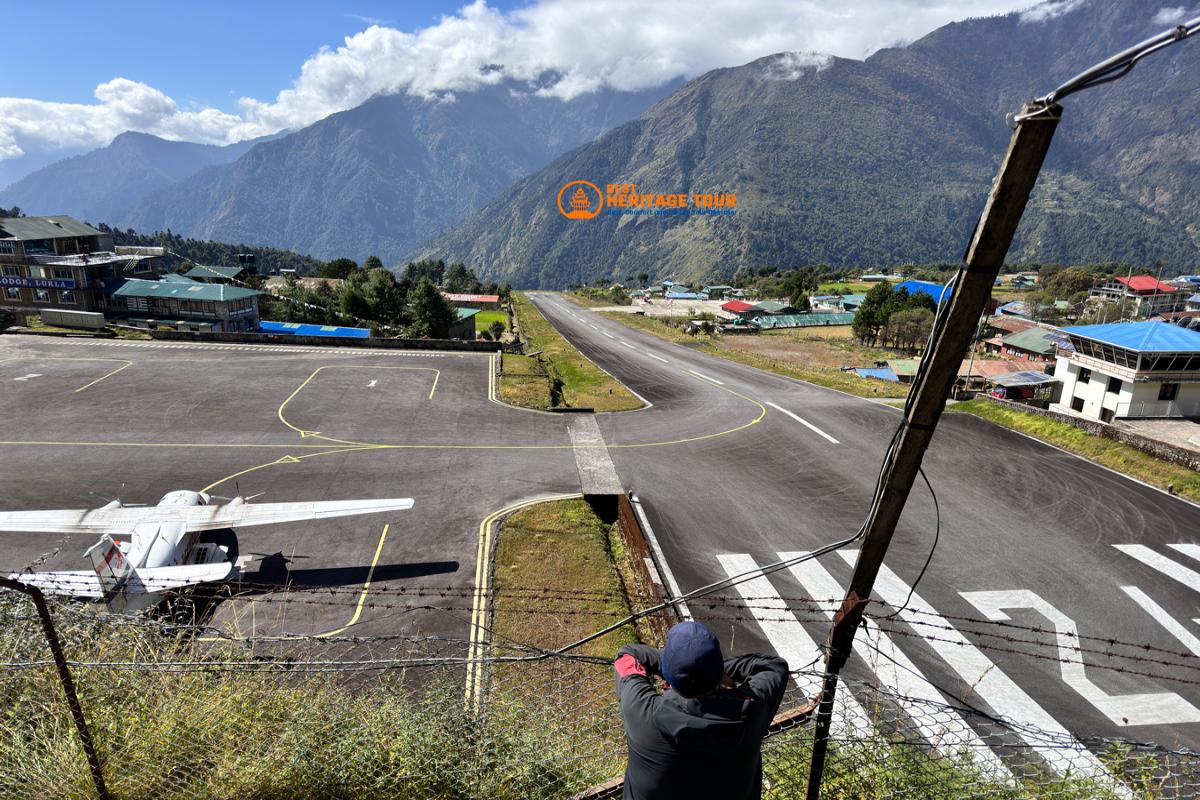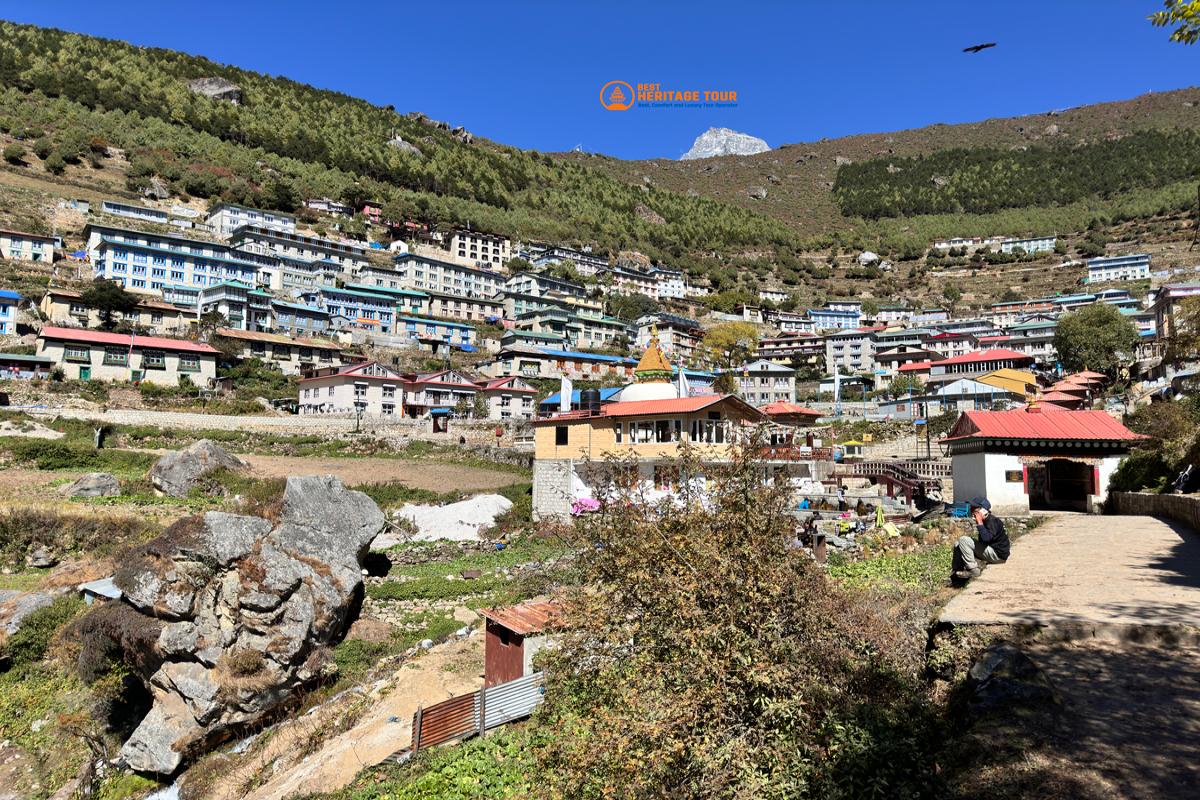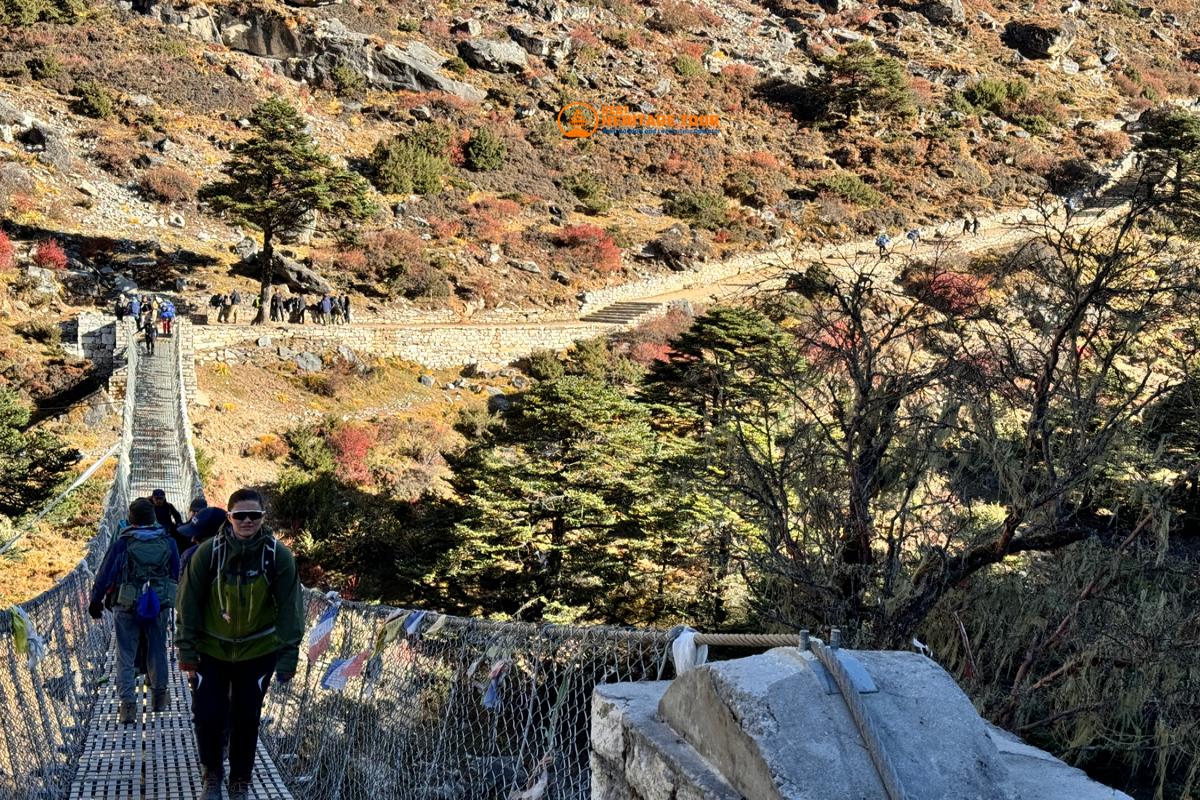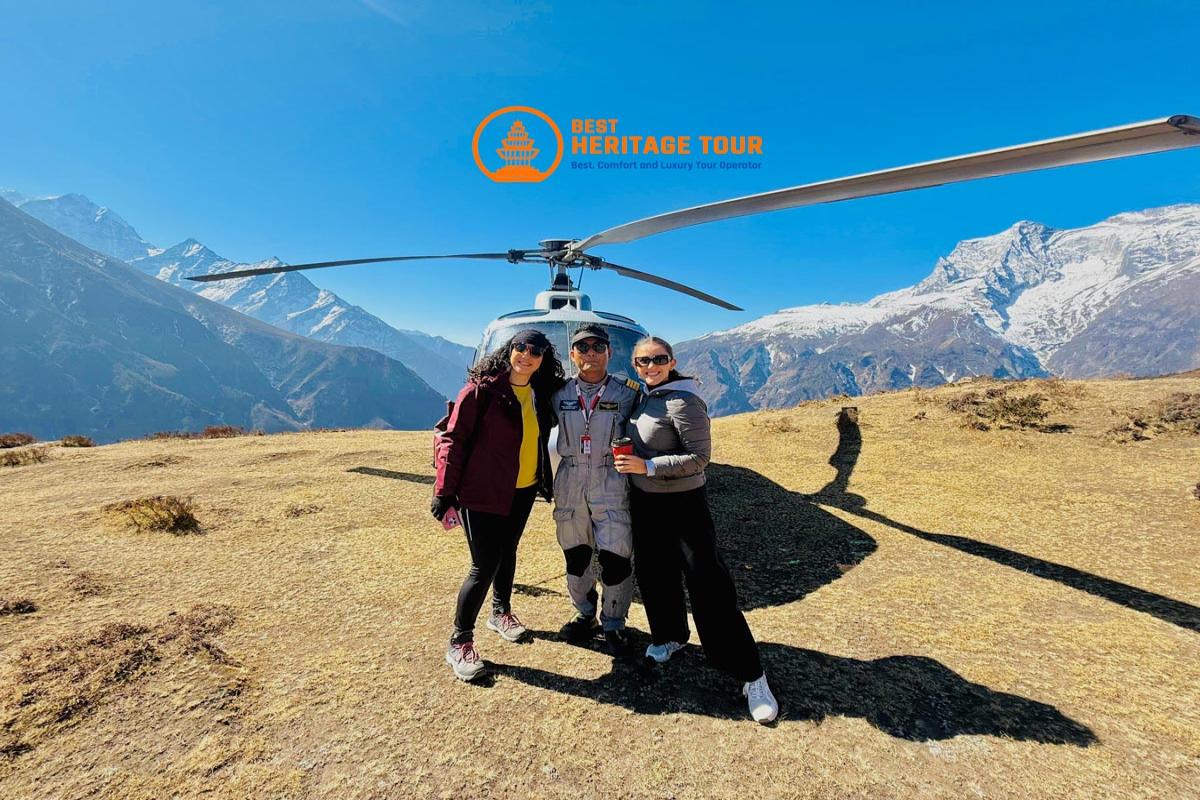Everest Base Camp Trek with Helicopter Return- 3 Days
Insight on EBC Trek with Helicopter Return
The Everest Base Camp Trek with Helicopter Return offers an exhilarating blend of adventure and luxury. Over three days, trek through vibrant Sherpa villages and ancient monasteries, immersing yourself in the rich Himalayan culture. The journey culminates with a thrilling helicopter flight over Everest Base Camp, Kala Patthar, and the Khumbu Glacier, providing unparalleled aerial views of the world's highest peaks. This expedition is perfect for those seeking an unforgettable Himalayan experience within a limited timeframe.
Trip at a Glance
Key Highlights
- Majestic flight to Lukla, one of the most attractive airports in the world
- Amazing trekking through Sherpa villages, Himalayan flora and more
- Visit fascinating Buddhist monasteries
- Cross the Hillary Suspension Bridge
- Explore Namche Bazaar, the main town in the Everest area.
- Explore the National Park Museum
- Trek to Everest View Hotel (3880m) and enjoy the stunning views of the Himalayan mountains, including Everest.
- Helicopter tour (flight over) to Everest Base Camp, Kala Patthar and Khumbu Glacier
Benefits of booking EBC Short Trek with Helicopter Return with Best Heritage Tours
- Free airport to hotel transfer on arrival and departure.
- Online trip discussion after booking confirmation
- Free excess baggage storage at BHT store during the trek
- Pulse oximeter to monitor blood oxygen saturation and detect early signs of altitude sickness at high altitudes
- Emergency medical equipment
- For your comfort, we also provide sleeping bags and down jackets for those who do not have them.
- Easy booking and reservation system
- We offer various communication channels such as Email, WhatsApp, Facebook, WeChat, Viber, Skype and Zoom to ensure seamless connection.
Trip Overview
Namche Bazaar trek with helicopter flight to Mount Everest Base Camp is one of the best and most luxurious ways to explore the Everest region and its highest peaks such as Mount Everest, Mount Lhotse and Mount Amadourmet. This is a short and majestic trek to explore the high Everest ranges of the Himalayas, experience the Sherpa culture, visit monasteries and marvel at the unique vegetation of the Himalayas.
Located at an altitude of 3,440 meters, Namche Bazaar is one of the most popular cities in the entire Khumbu region and the gateway to Everest. Besides some magnificent monasteries, museums and observation towers, this small unofficial headquarters is equipped with a hospital, bank, ATMs, a bar, a billiard house, a bar and a disco for a quality time spent at this altitude. Travelers can spend days exploring and hiking to the Sherpa villages, Khumjung village and hilltop observation towers. The entire region is part of Sagarmatha National Park, a UNESCO World Heritage Site. Therefore, this trail is a protected area with diverse vegetation, flora and fauna as well as Sherpa culture and customs. The adventure commences with a swift aerial passage from the vibrant city of Kathmandu to the enchanting destination of Lukla. After landing, you will have enough time to explore the first village in the Khumbu region. The hike then starts through villages, farmlands and forests with some ascents and descents and continues to Phakding or Monjo. Spend the first night in a quiet riverside village and the next day continue climbing a steep uphill to reach Monjo village, the main gate of Sagarmatha National Park.
After the permit check, continue climbing the stone steps to Jorsar. After a brief rest, the hike proceeds to Hillary Bridge and then climbs up to Top Dada.Here you will get your first view of Everest and then continue hiking towards Namche Bazaar. Explore the Sherpa capital, visit a monastery and have a great night at the hotel. The next day, visit the Everest View Hotel (3,880 m above sea level) and explore the vast Himalayan ranges including Mt. Everest. You will take a helicopter ride to Everest Base Camp and Kala Patthar.After an unforgettable time exploring the Himalayan ranges, descend to Namche Bazaar, Lukla or Kathmandu.This itinerary can be adjusted based on your schedule and preferences.
Alternative routes for beginners, seniors and children
Day 1: Flight to Lukla and hike to Phakding
Day 2: Hike to Jorsar
Day 3: Hike to Namche Bazaar
Day 4: Explore Namche Bazaar, hike to Everest View Hotel, helicopter tour to Everest Base Camp and descend to Namche Bazaar.
Or same day flight to Kathmandu or Lukla
Day 5: Descent to Lukla
Day 6: Flight to Kathmandu
Itinerary
The trek starts with a majestic flight to Lukla (2,840 m above sea level) and continues to Phakding after a snack break in Lukla. The walk continues with some ascents and descents through villages and farmland. After some river crossings, the trail crosses the river and enters Phakding.
The hike starts after breakfast and continues hiking to Monjo for permit check, then climbing to reach Jhorsar and then Hillary Suspension Bridge. Further climbing will bring you to the hill point (Top Dada) from where you can get a glimpse of Everest. After that, the trek continues uphill all the way to Namche Bazaar. Afternoon stroll around Namche Bazaar and visit a monastery.
Today is going to be one of the most awaited days. Hike to National Park Museum, visit Everest View Hotel (3,880 m) and explore the mesmerizing Himalayan ranges while having tea/coffee.
Finally, fly to Pheriche (4,371 m) by helicopter and spend unforgettable time exploring the Himalayan ranges. After that, helicopter flight continues to Everest Base Camp, Kala Patthar, Khumbu Glacier and finally return to Kathmandu via Lukla or descend to Namche Bazaar on the same day.
What is included?
- Collection and return transport
- Experienced trekking guide
- Sagarmatha National Park permit
- Pasang Ramnu permit
- TIMS approved
- Lukla round trip air tickets
- All ground transport
- Accommodation at tea houses during the hike
- Meals during the hike (breakfast, lunch, dinner)
- First aid kit
- Water purification tablets/liquids
- Trekking poles for hiking
- Duffel bag during the hike
- Take a helicopter ride to the base camp and Kala Patthar.
- Best Heritage Tour cap & T shirt
What is not included?
- Accommodation in Kathmandu
- Personal expenses (WiFi, hot shower, mineral water bottles etc.)
- Straps for carrying bags
- Tipping guides
- All government taxes 13%, SSF, and 10% service charges
Route Map
Trip Info
Lukla altitude and Overview
Lukla is a small town in the Everest region, mainly inhabited by the Sherpa community. It is the gateway to Everest where trekkers board their flights. Located at an altitude of 2840 meters, Lukla helps trekkers acclimatize after the flight and descend to Phakding for the first overnight stay.
Lukla, located between the hills, has a small but busy airport where trekkers start their trek by flying from Kathmandu. This helps shorten the overall number of days of trekking to the Everest region. There is a small airport, hotel, hospital and ATM, and trekkers spend their last night in Lukla while descending the trek and fly to Kathmandu the next day.
Lukla to Phakding Flight
Lukla to Phakding is a downward route in terms of altitude. After landing at Lukla airport, trekkers spend some time exploring the surrounding area before continuing the trek to Phakding. The hike continues to the entrance gate of Pasang Ramunu, stopping here for permit formalities and then hiking through villages and farmlands. You will cross a suspension bridge over a stream, pass through several Sherpa villages and reach Phakding. However, it is an easy hike with some ascents and descents. If you arrive in Lukla early, you can continue the hike to Monjo, where you will spend your first night.
Namche Bazaar Elevation and Overview
Namche Bazaar is one of the most popular cities in the entire Khumbu/Everest region. It is also one of the unofficial capitals and a trade and commercial center for the local population. Located at an altitude of 3,440 meters, Namche Bazaar is the gateway to Everest Base Camp. This is where trekkers stay for two nights on their way to Everest Base Camp and one night on their way down.
On the second day, trekkers hike up to Everest View Hotel (3,880 m) and explore the vast Himalayan ranges, including Mount Everest. This extra day also helps trekkers acclimatize to the high altitude.
Phakding to Namche Bazaar
Pakding is the first overnight camp where trekkers stay during the trek to Mount Everest Base Camp. A small Sherpa village, Phakding is located at an altitude of 2610 meters/8563 feet, lower than Lukla. Trekkers will trek to Phakding for about 4 hours after landing at Lukla airport. Phakding is surrounded by green forests and is close to the Dudh Koshi River.
After spending the first night at Phakding, the hike continues to Monjo and the permit check. You will trek further through dense forests and cross a suspension bridge over the Dudh Koshi River to reach Top Dada. Here you will get your first view of Everest. After another 2-3 hours of hiking, you will reach Namche Bazaar. Everest View Hotel Height/Altitude
Everest View Hotel is perfectly located for Everest trekking. Located at an altitude of 3,880 meters, it is the first hill station for trekkers to explore the vast Himalayan range including Everest.
Trekkers will spend two nights at Namche Bazaar for altitude acclimatization and the next day will join a day tour to Everest View Hotel, which is about 440 meters higher than Namche Bazaar. Everest View Hotel offers breathtaking views of the Himalayan ranges, Khumjung village and the diverse vegetation of the Everest region. In addition, you can also visit the National Park Museum during this trek. Namche Bazaar to Everest View Hotel
Namche Bazaar is the second camping spot for trekkers, where they stay for two nights to help their bodies adjust to the altitude. The next day, hikers trek to a nearby hill station also known as Everest View Hotel (3880 m). After breakfast, trekkers start the three-hour journey to Everest View Hotel, a high mountain with majestic views of the Himalayas in the distance.
Hikers can also visit the National Park Museum, which provides excellent information on the diverse flora and fauna of the Himalayas and Sherpa culture. This trek also allows you to see yaks and mountain goats (tahr) along the way.
Namche to Everest Base Camp
Namche Bazaar to Everest Base Camp is an additional five-day trek that includes an acclimatization day at Dingbuche. However, it will take another 2 days to return from Everest Base Camp to Namche Bazar. This makes it a 7-day trek from Namche Bazar to Everest Base Camp.
However, the best alternative is to fly by helicopter from Namche Bazar to Everest Base Camp on the same day and return to Namche Bazar or Kathmandu. This suits those who do not have enough time for a long trekking holiday and are not comfortable hiking at such altitudes.
Everest Base Camp to Kathmandu
Trekkers from Everest Base Camp can descend to Lukla in just 3 days. Alternatively, you can fly to Kathmandu by helicopter on the same day, or land in Lukla and fly to Kathmandu the next day.
This alternative allows you to minimize the number of trekking days and is suitable for those who do not have enough time and do not want to go down the same path all the time.
Is this hike suitable for me?
The trek to Namche Bazaar is a simple mountain path that goes through the lower areas of the Himalayas. After arrival at Lukla airport, the hike begins. After a short break, you will continue hiking with some ascents and descents until you reach Phakding. However, for beginners, the climb to Namche is a bit long and challenging as it has an elevation gain of over 800 meters. You will climb through the forest and cross the Dudh Kosi River via a suspension bridge.
If you are new to trekking, you can also choose to trek to Monjo on the first day and then trek to Namche Bazaar. This will reduce your trekking time on the second day by 1.5 hours. Or for older trekkers, Lukla to Namche Bazaar can be a 3-day trek. She is as follows:
Kathmandu-Lukla-Pakding
Pakding Jhorsar
Jhorsar Namche
Once trekkers arrive at Namche Bazaar, the following day features a leisurely hike to the Everest View Hotel, which is at 3,880 meters.This is a 4-hour full-day tour that offers spectacular views of the remote Himalayan ranges, including Mt. Everest, Mt. Lhotse, Ama Dablam, and more, and finally takes you to Everest Base Camp and then Namche Bazaar, Lukla, or Kathmandu.
Travel insurance for a 3-day trek to Everest Base Camp
Travel insurance is essential for your 3-day trek in Namche Bazaar. It should cover medical emergencies, problems especially related to the high altitude, and the possibility of trip cancellation or interruption due to unforeseen events. Make sure your insurance also covers your helicopter flight back to Kathmandu, accounts for weather delays, and that your belongings are protected during the trip.
Having the right travel insurance will ensure you are financially protected so you can enjoy your trek without worrying about unexpected issues. Covering health emergencies, trip interruptions, and problems that may arise during the helicopter flight will give you peace of mind on your Namche Bazaar adventure.
Review
Amazing views of Everest from Helicopter
Must say one of the best helicopter ride I had ever taken in my life. The views of EBC and Kala Patthar from the sky was just felt like out of the world. Watching the Everest peak...
View DetailAmazing aerial views of Mountains
What a wonderful helicopter ride to Everest Base Camp. The one week long trekking journey to EBC was just completed in 30 minutes. The views of mountains from EBC was very...
View DetailReached EBC with little trekking
This tour is perfect for someone like me who wants to reach EBC in short time with a feel of trekking. The trek portion was amazing. I crossed many small rivers and streams....
View Detailvery comfortable and easy tour to EBC
Very comfortable and amazing tour. Reached Everest Base Camp Kalapathar by helicopter with a little trekking. Got the chance to feel the Himalayas land, cold waters from the...
View DetailFAQ's
Yes, most visitors need a tourist visa to enter Nepal. A visa can be obtained on arrival at Tribhuvan International Airport in Kathmandu or applied for in advance at a Nepalese embassy or consulate.
Yes, you will need two passport-sized photos for both the visa application and the trekking permits, so it's a good idea to bring extra copies just in case.
You'll need a valid passport (with at least six months validity), a passport-sized photo, and the visa fee (which varies depending on the duration of stay).
Yes, it’s possible to extend your visa if you wish to stay longer in Nepal. Extensions can be processed at the Department of Immigration in Kathmandu or Pokhara, but you should apply before your current visa expires.
You can exchange US dollars or Euros for Nepalese rupees upon arrival, but we recommend carrying cash in the local currency for most transactions outside of major cities.
Physical preparation is essential to a successful trekking experience. Begin an exercise program 6-8 weeks before your hike that focuses on:
- Aerobic exercise: Activities such as running, cycling, and swimming to improve endurance.
- Strength training: Leg, core, and upper body exercises to increase strength.
- Practice hiking: Fill up your backpack and go on a short hike to simulate trekking conditions.
Yes, Nepal offers an electronic visa (e-visa) that can be applied for online before arriving. This process enables you to bypass the visa queue upon arrival at the airport. After completing the online application, you can get your visa stamped on arrival.
Yes, if you wish to extend your stay, you can apply for a visa extension at the immigration office in Kathmandu or Pokhara.
While Nepali is the primary language, most staff members in lodges speak English, and some may even speak other languages. Communication should not be an issue for international tourists.
It’s advisable to be up-to-date on routine vaccinations, including hepatitis A and typhoid. Talk to your doctor about the vaccinations you need for Nepal.
While basic medical services can be found in larger villages such as Namche Bazaar, serious health concerns may require helicopter evacuation.
The Namche Trek is a short trek in the Khumbu region of Nepal, taking you to Namche Bazaar, the gateway to Everest. This luxury trek includes a helicopter return from Everest Base Camp, allowing you to experience breathtaking views without the strenuous return trek.
The trek lasts three days, including one day for acclimatization and exploration in Namche Bazaar, and a helicopter return on the last day.
The helicopter return allows trekkers to fly from Everest Base Camp or nearby locations back to Kathmandu or Lukla. The flight offers stunning aerial views and is a quicker alternative to trekking back.
Choosing the best heritage tour provides an enriching cultural experience, blending education, comfort, and unique local interactions for unforgettable travel memories.
The trek offers opportunities to experience Sherpa culture, including visits to local monasteries, traditional villages, and markets in Namche Bazaar.
Yes, options such as mountain biking, rock climbing, and cultural tours are available in addition to trekking.
While it is possible to trek independently, it is highly recommended to hire a licensed guide for navigation, cultural insights, and safety in remote areas.
Yes, all our guides are fluent in English and many speak other languages. This facilitates clear communication and enhances your overall experience.
Luxury accommodations offer enhanced services, larger rooms, better amenities, and more personalized care compared to standard lodges.
The best months to trek are September to November and March to May when the weather is mild and clear.
Temperatures can vary significantly. In September and October, daytime temperatures in Namche can range from 15°C to 20°C (59°F to 68°F), while nighttime can drop to 5°C (41°F) or lower. In March and April, expect similar daytime temperatures, but nights can be colder.
Weather conditions in the Himalayas can change rapidly. Be prepared for rain, snow, or strong winds, especially in spring and autumn. It's crucial to have appropriate clothing.
If weather conditions prevent the helicopter from flying, the trekking itinerary may need to be adjusted, potentially requiring an extra night in the region.
Yes, most travelers require a visa. You can obtain a tourist visa on arrival at the airport or apply online in advance. It is essential to ensure that your passport remains valid for a minimum of six months from the date of your arrival.
The majority of international flights arrive at Tribhuvan International Airport, which is located in Kathmandu. From this location, travelers can connect to Lukla to commence their trekking journey.
You typically need a valid passport, a completed visa application form, and a passport-sized photo. Payment can be made in cash or via card at the airport.
Yes, tourist visas are eligible for extension at the Department of Immigration located in Kathmandu. Ensure you have a valid reason and required documents for the extension.
The luxury package typically includes accommodation, meals during the trek, a guide, helicopter return, and permits.
Additional costs may include international flights, visa fees, travel insurance, personal expenses, and optional activities.
Payments are typically accepted through bank transfer, credit card, or cash. However, it's best to confirm with the trekking agency beforehand.
Tips for guides and porters are typically not included and are recommended as a way to show appreciation for their services. A customary tip is approximately 10% of the total trek cost.
Although technical climbing skills are not necessary, having prior trekking experience is advantageous. This trek is suitable for anyone in good health and with moderate fitness levels.
There is no strict age limit, but children under 12 and older adults should consult a doctor before undertaking the trek.
Solo trekking is not allowed in the Everest region; you must be part of a guided group.
Yes, families can participate, but it's recommended that children be of a suitable age and fitness level for the trek.
You will stay in luxury lodges or hotels offering comfortable amenities, private bathrooms, and exceptional service in Namche Bazaar.
Most packages include daily meals; expect a mix of local and international cuisine prepared with fresh ingredients.
Many luxury lodges in Namche and higher areas offer en-suite bathrooms, but some may require shared facilities.
Some luxury lodges may offer laundry services, but it’s best to ask in advance. Alternatively, you can pack enough clothing to avoid needing laundry services.
Essential gear includes trekking boots, a warm jacket, layered clothing, a good quality sleeping bag, trekking poles, and personal items like sunscreen and a first aid kit.
Renting gear in Kathmandu is an option, but purchasing high-quality items is recommended if you plan to trek regularly.
Gradually acclimatize by spending extra time at higher altitudes, stay hydrated, and listen to your body. Consider medication for altitude sickness, as advised by your doctor.
While meals are provided, it’s a good idea to bring snacks like energy bars, nuts, or dried fruit for additional energy during the trek.
A moderate level of fitness is recommended. Engaging in consistent cardiovascular workouts, hiking, and strength training can effectively condition you for the trek.
While not mandatory, it’s advisable to consult with a healthcare provider to assess your fitness level and readiness for high-altitude trekking.
Incorporate cardiovascular exercises (like running, cycling, or swimming), strength training, and practice hiking on varied terrain to prepare your body for the trek.
It depends on the condition. Consult with your doctor to assess your health and ability to trek safely.
Consult with a doctor about vaccinations and altitude sickness medications. Stay hydrated and acclimatize properly.
Yes, travel insurance that covers trekking at high altitudes is essential for emergencies, including helicopter evacuation.
Inform your guide immediately. They are trained to handle health issues and can help with evacuation if necessary.
It's advisable to drink bottled water or use water purification tablets or filters. Avoid drinking untreated water from streams or local taps.
Yes, most lodges in Namche Bazaar provide electricity, but it may incur additional charges. Charging devices may also be available at some lodges.
Wi-Fi access is provided in certain lodges in Namche; however, its speed and reliability may be compromised.
You can use local SIM cards for your phone or access Wi-Fi in some lodges, but connectivity may be limited.
Always inform your guide about any emergencies. Ensure you have a contact number for your trekking agency and emergency services in Nepal.
A domestic flight lasting 30 to 40 minutes from Kathmandu to Lukla is typically included in most trekking packages.
Flights to Lukla can be affected by weather. It's advisable to have flexible plans and consider extra days in Kathmandu to accommodate potential delays.
Arriving at least one or two days before the trek is advisable to acclimatize and finalize any necessary arrangements.
If your luggage is lost, report it to the airline immediately. Most airlines have procedures for retrieving lost luggage, but it’s wise to carry essentials in your daypack.
The Everest Heli Tour is an exclusive helicopter experience that provides breathtaking views of Mount Everest and the majestic Himalayan range. It includes a scenic flight over the mountains, a landing at Kala Patthar (5,545 meters) for an up-close encounter with Everest, and possibly a visit to Everest Base Camp or other nearby attractions.
The total duration of this luxurious tour typically lasts 3 to 4 hours, encompassing the flight to and from Kathmandu and any planned stops during the journey.
Rest assured, the tour is meticulously designed with safety in mind. Reputable companies utilize top-notch helicopters, and their skilled pilots are well-versed in navigating high-altitude conditions. Nevertheless, like any thrilling adventure, there are inherent risks associated with the tour, primarily stemming from the altitude and weather challenges.
The prime time to embark on this extraordinary journey is during the pre-monsoon (March to May) and post-monsoon (September to November) seasons. During these periods, you can expect excellent weather conditions and perfect visibility to ensure an unforgettable mountain adventure.
Dress warmly in layers to combat the chilly temperatures at high altitudes, especially during early morning flights. It is advisable to don a down jacket, gloves, a hat, and sunglasses. Additionally, wear sturdy shoes suitable for walking on rugged terrain if you plan to explore the landing sites.
The helicopter typically soars at altitudes ranging from 3,500 meters (11,500 feet) to 5,500 meters (18,000 feet). The pinnacle of the journey often culminates at Kala Patthar, approximately 5,545 meters (18,192 feet) above sea level.
Although the tour is brief, some individuals may experience mild symptoms of altitude sickness due to the rapid ascent. It is crucial to stay hydrated, abstain from alcohol before the tour, and promptly notify the pilot if you feel unwell.
Absolutely, as long as they are in good health. This tour is generally suitable for individuals of all ages, but it is advisable to seek medical advice if you have any health concerns, particularly related to altitude.
In the event of unsuitable flying conditions, the tour may be rescheduled for another day. If rescheduling is not feasible, most operators offer a full refund or an alternative tour.
Yes, helicopters enforce weight restrictions for safety purposes. The standard weight limit is approximately 500 kg (1,100 lbs) for all passengers combined. Some operators may request your weight in advance for flight planning.
Most helicopters utilized for the Everest Heli Tour can accommodate 4 to 5 passengers, in addition to the pilot. For more extensive groups, we can coordinate multiple helicopters.
The pricing varies depending on the tour operator and the specific itinerary, with costs typically ranging from $1,000 to $5,000 per person. Private tours may incur higher expenses.
Yes, an entry permit is usually necessary for accessing the Everest region. The tour operator typically handles this process for you, and the fee is included in the tour package.
Absolutely! Capture awe-inspiring moments during the tour, especially at the Kala Patthar landing. Most operators encourage passengers to document their journey through photos and videos.
It is highly recommended to acquire travel insurance that covers high-altitude helicopter rescue and medical expenses. Some tour operators may mandate this for your safety and well-being.
If you wish to extend your stay in Nepal beyond your visa’s initial duration, you can do so by applying at the Department of Immigration in Kathmandu. Extensions are available for a maximum of 30 days, and it’s recommended to apply before your current visa expires. Best Heritage Tour can help you with the extension process if required during your Australian Camp Trek.

